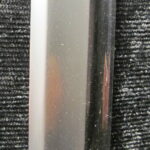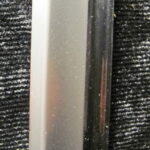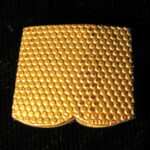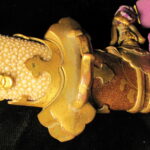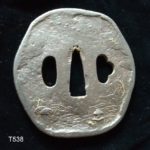Q830. Tachi by Osafune Sukenaga, Efu no Dachi Koshirae, Tanobe Sayagaki
$19,500.00
Q830. Kamakura era tachi with Efu no Dachi koshirae and Tokubetsu Hozon paper from the NBTHK in Tokyo, dated 2018 and giving it to Osafune Sukenaga.
Nagasa: 26″ 66 cm.
Sori: 2.3 cm.
Moto haba: 2.75 cm.
Moto kasane: .7 cm.
Saki haba: 1.4 cm.
Saki kasane: .35 cm.
Nakago nagasa: 7 1/4″ 18.3 cm.
Overall in shirasaya: 35 1/2″ 90.5 cm.
Shinogizukuri, iore mune, ko kissaki, strong koshi zori. The hada is a small itame with mokume elements in the finest of ji-nie. There is a midare utsuri. The hamon is suguba in a bright and consistent nioi guchi. The boshi is a continuation of the hamon, ending in a point with a short kaeri. There is a bo-hi on either side. This is in a high grade Japanese polish and, with the exception of one spot where the grain is a tiny bit coarse, it is flawless. My pictures show every inch.
The blade is mounted with a gold foil habaki (slight crumpling of the foil) and in a well made shirasaya with a small wooden tag saying “Osafune Sukenaga” and a sayagaki by Tanobe Michihiro of the NBTHK. We’ve had the sayagaki translated:
Bizen no Kuni Osafune Sukenaga
Ubu, mumei. Two mekugi ana, with the lower one being the original. This smith is from the latter part of the Kamakura period, circa Shōwa (1312-1317).
The style resembles Sanenaga, with an elegance that is his specialty. This sword displays that trait, as well as a clear midare utsuri, this is a fine work.
Sukenaga was the son or student of Nagamitsu. Bizen Nagamitsu was the son of Bizen Mitsutada, the founder of the Bizen Osafune School.
There is also a efu no dachi koshirae mounted with a tsunagi (wooden blade): gilt metal fittings with a finely lacquered saya. The gilding on the fittings is rubbed a bit here and there and there are a few rub marks on the lacquer – nothing even close to serious – and I can find no loss of lacquer. Excellent condition.
With the Meiji Restoration in 1868, The Emperor was once again the ultimate power in Japan, and the nation’s Daimyo (provincial governors) and other VIPs had to pay attention – they needed sword furniture suitable for a visit to court. This koshirae, most likely, dates to that time; it bears the Mon of the Wakizaka Daimyo.
Mark Jones and I bought this tachi from a collector who lived in Japan at the time he acquired it. He was then strongly encouraged to submit it for Juyo shinsa. He didn’t want the wait and expense; he stopped the paper hunt at Tokubetsu Hozon.
Elegant, elegant, elegant. This tachi reminds me of why I was 1st drawn to Nihonto. 4 pounds. $19,500.
Sold Out
Sold Out




























